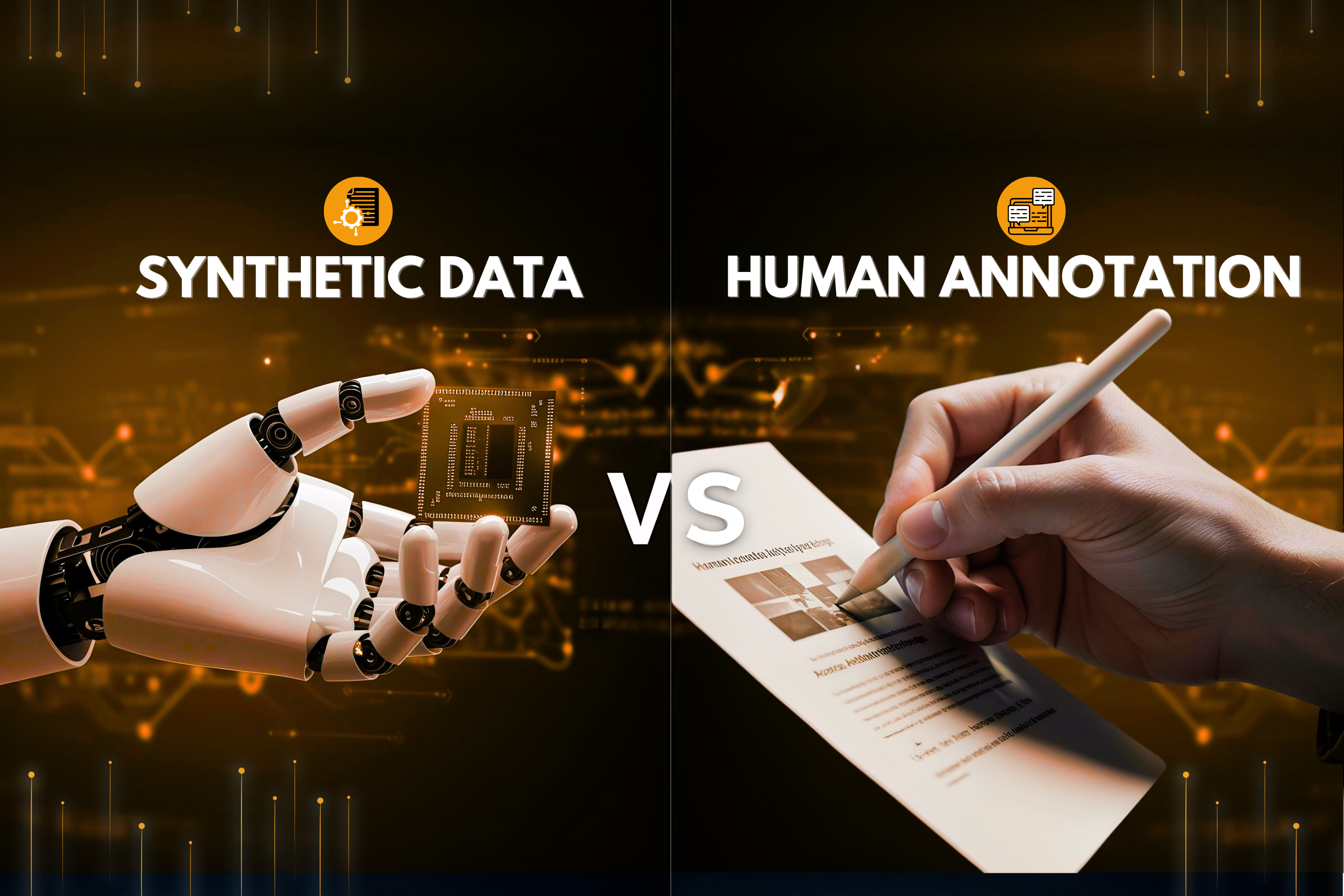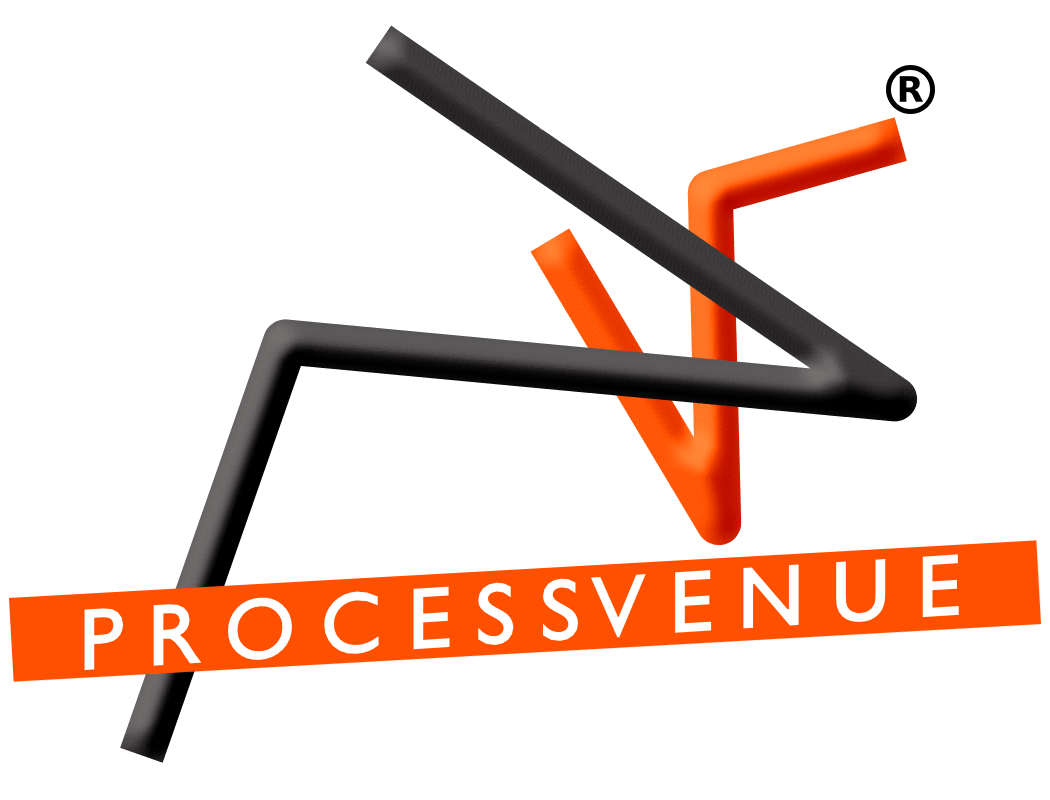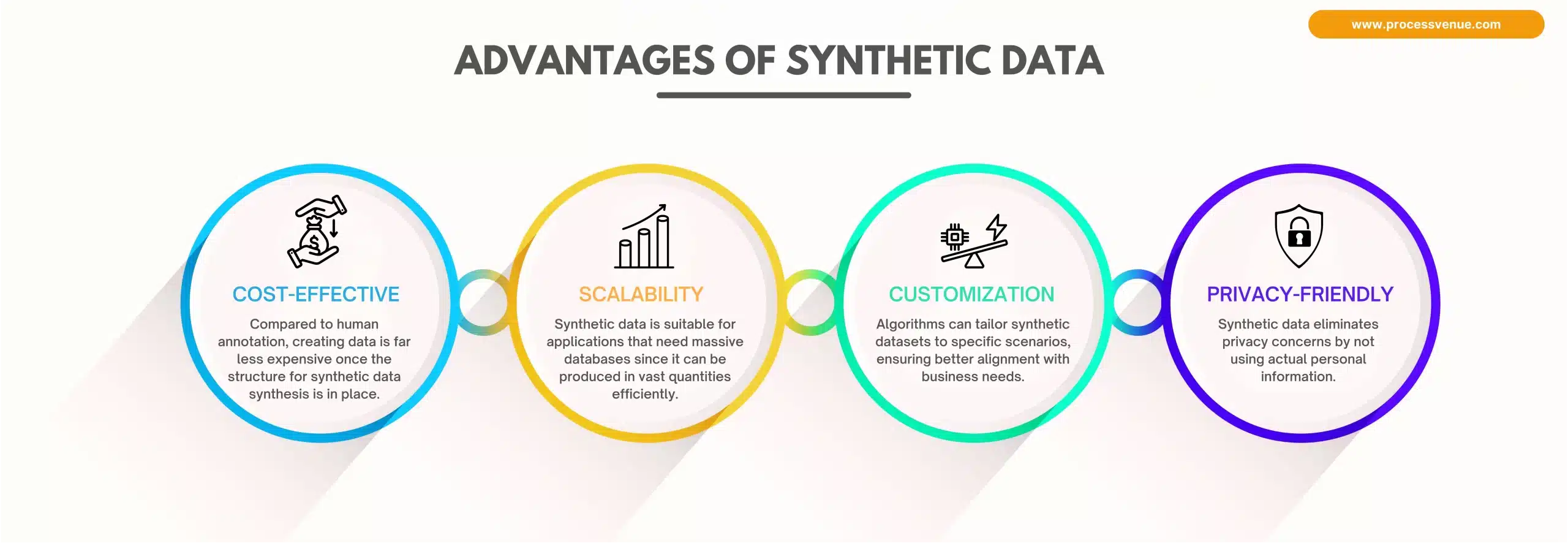
Synthetic Data Vs Human Annotation: Which is more Effective for Machine Learning?
|
Getting your Trinity Audio player ready...
|
Data is the lifeblood that propels innovation in the emerging fields of machine learning (ML) and artificial intelligence (AI). Whether you’re training a model to detect fraud, predict customer behaviour, or navigate autonomous vehicles, the quality and quantity of your data are critical. Two popular approaches to creating datasets for ML are synthetic data generation and human annotation. Interestingly, which one works better? Let’s dive into that conversation and explore how ProcessVenue’s services can help organisations utilize the best of both worlds.
What is Synthetic Data?
Synthetic data refers to artificially generated datasets created using algorithms to mimic real-world data patterns. It is particularly useful when real-world data is scarce, sensitive, or costly to collect. For example, synthetic data can provide balanced datasets to maximize training of machine learning models or spread unusual situations.
Advantages of Synthetic Data
- Scalability: Synthetic data is suitable for applications that need massive databases since it can be produced in vast quantities efficiently.
- Cost-effectiveness: Compared to human annotation, creating data is far less expensive once the structure for synthetic data synthesis is in place.
- Privacy-friendly: Synthetic data eliminates privacy concerns by not using actual personal information.
- Customization: Algorithms can tailor synthetic datasets to specific scenarios, ensuring better alignment with business needs.
Challenges of Synthetic Data
- Lack of Nuance: Synthetic data often fails to capture subtle contextual or cultural nuances that are critical for certain applications
- Bias Propagation: If synthetic data is derived from biased real-world datasets, it can perpetuate those biases in ML models
- Dependence on Real Data: Synthetic data requires high-quality real-world datasets as a baseline, limiting its standalone effectiveness
What is Human Annotation?
Human annotation entails skilled experts manually labelling and tagging data. This approach guarantees that datasets are precise, complex, and pertinent to the context. Applications such as image identification, natural language processing (NLP), and medical diagnostics regularly call for human annotation.
Advantages of Human Annotation
- Superior Accuracy: Human annotators excel at understanding complex contexts and spotting subtle details that machines often miss
- Domain Expertise: For specialized fields like healthcare or finance, human experts provide precision that synthetic methods cannot replicate.
- Bias Mitigation: Humans can identify and address biases in datasets, ensuring fairness and inclusivity in ML models
- Real-world Applicability: Human-generated annotations prepare models for messy, inconsistent real-world scenarios better than synthetic counterparts.
Challenges of Human Annotation
- Cost and Time Intensive: Manual annotation is expensive and time-consuming, especially for large datasets.
- Scalability Issues: It becomes impractical to annotate millions of data points manually without significant resources.
- Repetitive Tasks: Human annotators may experience fatigue or errors when working on monotonous tasks over extended periods.
Which Approach Wins?
The answer depends on your specific use case. While accuracy and detail are synthetic data’s weak aspects, scalability and cost-effectiveness are its notable advantages. Human annotation, on the other hand, provides outstanding accuracy but is more extravagant and draining.
Interestingly, research shows that the best results are obtained when the two approaches are combined. Models trained primarily on synthetic data can achieve significant performance improvements by incorporating even small amounts of human-labelled data. For example, adding just 125 human-generated data points can dramatically enhance model accuracy when synthetic data forms the bulk of the dataset.
How ProcessVenue can help?
Our specialty at ProcessVenue involves bringing together the advantages of human annotation and synthetic data production to produce exceptional datasets that are personalised to meet your company’s requirements. Here’s how our offerings stand out:
High-Quality Data Annotation Services
- Our team provides detailed human annotation for images, text, audio, and video to ensure accuracy and context relevance.
- We integrate human-in-the-loop systems for quality assurance, ensuring your ML models perform reliably even in complex scenarios.
Synthetic Data Solutions
- We use cutting-edge algorithms to generate scalable synthetic datasets that address gaps in real-world data availability.
- Our synthetic solutions are privacy-friendly and customizable to meet specific industry requirements like healthcare or finance
Hybrid Approach
- By combining synthetic and human-labelled datasets, we help businesses achieve cost-effective scalability while maintaining accuracy.
- This dual strategy ensures robust AI models capable of generalizing across diverse scenarios while minimizing biases.
Tailored AI Models
- ProcessVenue designs AI models optimized for your unique business objectives using enriched datasets from both approaches.
- Our solutions empower smarter decision-making through actionable insights derived from high-quality training data.
Takeaway
Imagine you’re developing an AI model for fraud detection in financial transactions. Would you rely solely on synthetic data to simulate fraudulent patterns? Or would you prefer human annotators who can spot nuanced anomalies in real-world transaction logs?
The best solution might be a hybrid approach—leveraging synthetic data for scalability while using human expertise to fine-tune critical edge cases.
Conclusion
The ML ecosystem encompasses both human annotation and synthetic data. While synthetic data presents speed and scalability, human annotation ensures precision and contextual comprehension. By carefully utilizing these techniques, businesses can fully utilize their AI models.
With ProcessVenue’s proficiency in AI-powered solutions and superior annotated datasets, you can stay ahead of the competition and manage this ever-changing terrain with confidence. Are you geared to transform your company’s operations? Together, let’s create higher-performing AI!
FAQs
Can synthetic data completely replace human annotation?
No, synthetic data cannot fully replace human annotation. While synthetic data is excellent for scalability and simulating rare events, it often lacks the nuance and precision that human annotators provide. A hybrid approach combining both methods is often the most effective solution.
Is synthetic data reliable for sensitive industries like healthcare or finance?
Synthetic data can be highly effective in sensitive industries, particularly for addressing privacy concerns. However, it should be complemented with human annotation to ensure accuracy and context-specific insights, especially in critical applications like medical diagnostics or fraud detection.
How does ProcessVenue ensure the quality of annotated datasets?
ProcessVenue uses a rigorous quality assurance process with human-in-the-loop systems to verify annotations. Our team of domain experts ensures that every dataset meets high standards of accuracy, relevance, and fairness.
How much does it cost to use human annotation compared to synthetic data?
Human annotation tends to be more expensive due to the manual effort involved, whereas synthetic data is cost-effective once the infrastructure is set up. However, ProcessVenue offers tailored solutions that balance cost and quality by combining both approaches.
How can I decide which approach is best for my ML project?
The choice depends on your project requirements:
· Use synthetic data if scalability and cost are priorities.
· Opt for human annotation if accuracy and nuanced understanding are critical.
· Consider a hybrid approach for optimal results. ProcessVenue can help you analyse your needs and implement the right strategy.
How does ProcessVenue’s hybrid solution improve ML models?
ProcessVenue combines the scalability of synthetic data with the precision of human annotation to create enriched datasets. This hybrid approach reduces biases, improves model accuracy, and ensures generalizability across diverse scenarios.
Can ProcessVenue help with ongoing dataset updates?
ProcessVenue combines the scalability of synthetic data with the precision of human annotation to create enriched datasets. This hybrid approach reduces biases, improves model accuracy, and ensures generalizability across diverse scenarios.
How do I get started with ProcessVenue’s AI & ML offerings? Getting started is easy! Visit ProcessVenue’s AI & Machine Learning offerings to explore our services or contact us directly for a consultation tailored to your business needs.
With these FAQs addressed, you’re now equipped to make informed decisions about leveraging synthetic data and human annotation for your machine learning projects.
Ready to take the next step? Partner with ProcessVenue today!

